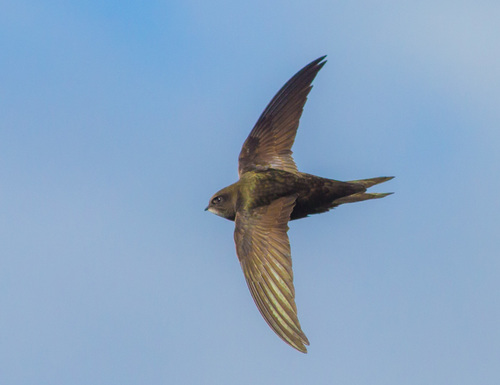
Common Swift
The Common Swift (*Apus apus*) is a remarkable aerial bird, renowned for its extraordinary flight capabilities and almost entirely airborne lifestyle. It is a summer visitor to Europe and Asia, migrating vast distances to winter in sub-Saharan Africa. Ecologically, swifts play a vital role in controlling insect populations, consuming vast quantities of flying insects. While not possessing vibrant colors, their sleek, streamlined bodies and exceptional flight endurance have fascinated birdwatchers and scientists for centuries. They hold a place in folklore, often associated with summer and good weather.
16-17 cm
Length
42-48 cm
Wingspan
Least Concern
Conservation Status
Distribution
Breeds across Europe and Asia, from Ireland and Portugal in the west to eastern China and Siberia. Migrates to sub-Saharan Africa for the winter, covering thousands of kilometers. Found at varying altitudes, from sea level to mountainous regions.
Lifespan
Average lifespan in the wild is around 5-7 years, but some individuals have been recorded living over 20 years.
Common Swift's Habitat
Habitat Types
Urban areas, Rural landscapes, Cliffs, Open woodlands
Climate Zones
Temperate, Boreal, Mediterranean
Adaptations
Highly adapted to an aerial lifestyle; rarely lands except to breed. Short legs and strong claws are suited for clinging to vertical surfaces. Their streamlined body and long, pointed wings are perfect for sustained, high-speed flight.
Variations
Two main subspecies are recognized: *Apus apus apus* (the nominate subspecies) and *Apus apus pekinensis* (found in central Asia). Differences are subtle, primarily relating to plumage coloration.
Appearance
Breeding Plumage
Plumage is generally uniform throughout the year.
Seasonal Feather Changes
No significant seasonal variation.
Sex Based Plumage Differences
Males and females have very similar plumage.
Notable Features
Sooty-brown plumage overall, with a small pale throat patch., Long, sickle-shaped wings., Short, forked tail.
Diet and Feeding
Primary Foods
Flying insects, Aerial spiders
Foraging Behavior
Forages entirely in flight, catching insects in its wide gape. Often feeds at high altitudes, following weather fronts and concentrations of prey. Drinks by skimming the surface of water bodies.
Specializations
Wide gape and specialized throat muscles for capturing and swallowing insects in flight.
Seasonal Diet Variations
Diet composition varies depending on insect availability, but generally consists of a wide range of flying insects throughout the year.
Behavior
Social Structure
Highly social, often seen in large flocks, especially during migration and when feeding. Breeds in loose colonies.
Communication
Loud, piercing 'sreee' calls, often given in flight., Vocalizations used for communication within the flock and during courtship.
Migration
Undertakes long-distance migrations between breeding and wintering grounds. Travels in large flocks, often following coastlines and mountain ranges. Remarkably, young swifts may stay airborne for up to two years before landing to breed for the first time.
Territorial or Group Behaviors
Defends the immediate area around the nest site. Otherwise, highly gregarious.
Conservation
Threats
Loss of nesting sites due to building renovation and demolition., Decline in insect populations due to pesticide use., Climate change, affecting migration timing and prey availability.
Protection Programs
Provision of artificial nest boxes., Awareness campaigns to promote swift-friendly building practices.
Local National Laws
Protected under various national and international wildlife legislation, such as the EU Birds Directive.
Population Trend
Stable
Population Estimates
Global population estimated to be between 40,000,000-49,999,999 individuals.
Interesting Facts
Swifts can sleep on the wing.
They ascend to high altitudes at dusk and are believed to enter a state of sleep while gliding.
They can fly at speeds of over 100 km/h.
This makes them one of the fastest birds in level flight.
Swifts can remain airborne for up to 10 months at a time
This incredible feat is achieved by feeding, drinking, and even mating in flight.
Faqs about Common Swift
Where do swifts go in the winter?
Common Swifts migrate to sub-Saharan Africa for the winter.
What do swifts eat?
They eat flying insects and aerial spiders, catching them in their mouths while flying.
How can I help swifts?
You can help by providing nest boxes, avoiding the use of pesticides, and supporting organizations that work to protect swift habitats.
Do swifts return to the same nest site each year?
Yes, swifts are known for their strong site fidelity and often return to the same nest site year after year.
Copyright @ Nature Style Limited. All Rights Reserved.
 English
English